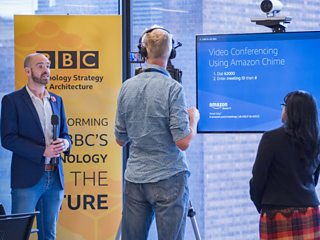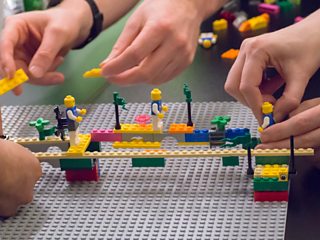Empowerment and disruption - our strategy and architecture teams discuss technology transformation
Sandeep Thandi
Lead Architect, Design & Engineering
One of Design & Engineering’s Lead Architects, Sandeep Thandi, talks about the recent Technology Strategy & Architecture Community event, which saw over 90 people come together from across the division.
It was with a feeling of excitement and anticipation that I set off for my first Technology Strategy & Architecture (TS&A) Unconference day, their third such event designed to bring together the ��������’s community of technical strategists and architectural practitioners.
The theme was Empowerment & Disruption, a topic close to my heart having read a number of books on business innovation including The Business Model Generation, The Science of Serendipity & The Lean Start Up. The event was hosted at Amazon’s HQ in London (who are no strangers to disruption) so it promised to be an insightful day.
Andy Conroy, Controller of �������� Research & Development, delivered an energetic conference opener which reflected on how we are an organisation with a long history of innovation and creativity. We have people in our organisation who innovate every day and who, when given the space, time and community to collaborate, can produce world-class and innovative results. But to get even better, we need to be bolder and more daring in our approach.

Innovation = Shared Community
If any part of the day embodied empowerment within the ��������, it was the stories shared by other members of the community - from iPlayer anecdotes to Jedi proverbs - and it soon became obvious to me that innovation takes many forms. What really hit home was that this community is already doing a number of great things and all the solutions to our problems had come from people within the room.
Legacy = Success
Anne Boden, Founder and Chief Executive Officer of Starling Bank, shared her inspiring experiences, which stemmed from wanting to be part of fixing a broken industry. By realising “the things I knew were actually wrong” and learning from Fintech organisations, Anne got a taste of doing things faster. The fundamental operating principle described was agile decision-making and the only things that matter are those which go the customer.

That’s all great for start-up, but what about large enterprises? The trick is to think about legacy as success. We talk about legacy as a negative thing to avoid, however it actually represents the ability to serve a large customer base and serve it well. If we chose to accept it, our challenge now is to serve that customer base in even better ways.
What really struck me about this fundamental leap to fix a broken industry was the need to unlearn all the things believed to be true. Next time someone tells you it can’t be done or shuts down your idea we should ask ourselves: Is this really true or just “how we do things here”?
Challenging the status quo could mean an answer that delivers a better experience to our audiences or internal colleagues – as once said, “Anyone who wants to lead an orchestra must turn their back on the crowd”.
Good = It’s just like TV
Technology is enabling changes to audience viewing habits. This is why being a catalyst for driving digital transformation is a key objective for TS&A.
This disruption is causing multiple industries to head towards a collision course, as Matt Stagg, Head of Mobile Video at EE explained in his talk about how trends in audio and visual media consumption have impacted the telecoms industry.

Whilst network and bandwidth challenges in some parts of the country were acknowledged, customer fear of running out of data on their mobile packages is a barrier to how they consume content on their mobile devices. Matt calls this the Choco-Dip effect. It doesn’t look like there is enough chocolate to coat all the breadsticks, so we restrict the amount we use, but in the end we are left with no breadsticks and a surplus of chocolate which might end up being wasted.
Some customers end up in the same situation with their mobile data. It sounds silly, but that makes me wonder what other barriers or constraints do we put ourselves under when coming up with new solutions.
In our response to changes in technology & viewing behaviour, a question remains true; regardless of where we deliver content and how viewing behaviours change, the level of quality is set to: Does this look as good as it does on TV? Addressing this challenge is mandatory for the industry. This is where the technical solutions and debate become interesting and far-reaching. An example of how to address this was in the delivery of the award winning demo of .
When I asked Matt why he was excited about speaking to the ��������, he replied that as one of the main providers of content, they wanted to work with the �������� to provide us with an opportunity to influence and exploit new technology that would bring great content delivery experiences to our audiences.
Transparency is essential for any organisation serious about transformation. This was highlighted in Connon MacRae’s description of . This applies to organisational structure, cultural boundaries and costs.
And then there was Lego…

If you think you know all there is to know from playing with Lego, then think again….During the final activity of the day we were set the Lego Challenge – whereby one team built a Lego model with a set of instructions for another team to follow and build an exact replica. Here are the two lessons I learnt from this serious play activity:
- Those who shout loudest get heard. Literally, the winning team shouted “we are the best”! We have all been in situations where the idea selected might not be the best, but chosen because it came from someone who has been shouting loudest.
- “Yes, and…” rather than “No, but”. The facilitator simply smashed apart one group’s structure. The emotion around the room was shock and sadness and this was just a Lego structure built a few minutes earlier. This powerful (and disturbing) metaphor highlights our behaviour when we destroy our colleague’s ideas and when we let our ideas get attacked by others.
At the end of the day, I reflected on a whole new set of vocabulary I had learnt, which embodied Empowerment & Disruption. These were not the words from a glossy best seller but came from real people inside and outside of our organisation.

"You need an MBA to innovate" explained Andy Conroy. "That’s right; you need Mindset, Beliefs, Approach!" Innovation comes from ordinary people if we empower ourselves, give ourselves the time and space to collaborate, but also be brave. We are also responsible for not crushing the ideas of others in the community because it is working with the community that will enable us to be more innovative every day.
